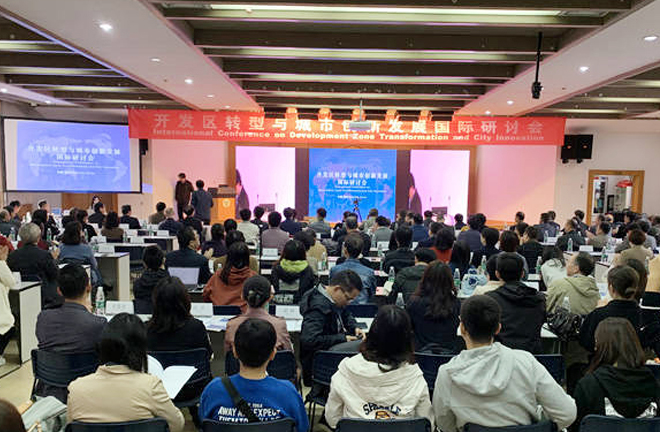Integration of industrial and urban development points the way

The International Conference on Development Zone Transformation and City Innovation was held in Nanjing on Nov. 16. Photo: Wu Nan/CSST
How to predict, handle and adapt to the innovation and development of global cities and promote the transformation of development zones is a new challenge and a new task faced by global cities. Recently, the International Conference on Development Zone Transformation and City Innovation was hosted by the Southeast University and Urban Planning Society of China in Nanjing. More than 300 representatives from over 10 countries along the Belt and Road (B&R) shared their experiences in the urban innovation and transformation of development zones with a view of finding solutions through increased international cooperation and mutual learning.
Guo Li, director of China South-South Industrial Cooperation Center of the United Nations Industrial Development Organization, said that there are many types of industrial parks in China, such as the China National Economic and Technical Development Zone, China National High-Tech Industrial Development Zone, special customs supervision area, and cross-border economic cooperation zone. These industrial parks play an important role in China’s continued economic development.
Claude Ngomsi, a senior official of the United Nations Human Settlements Programme (UN-Habitat), said that the urbanization of African countries faces challenges such as relatively backward manufacturing industries and a disjunction between urbanization and industrialization. Ethiopia and Rwanda and other African countries can learn from China, deepen China-Africa cooperation, and strengthen the link between urbanization and industrialization through the establishment of various industrial parks and special economic zones, so as to further promote urban innovation and economic transformation.
Mohsen Aboulnaga, a professor from the Faculty of Engineering at Cairo University, introduced and explained successful cases of urban sustainable development. He pointed out that the city of Rotterdam in the Netherlands encourages all sectors of society to participate in the formulation of urban construction plans and environmental protection schemes, and it has launched the Happy Streets experiment for its residents to jointly contribute to the purification of urban groundwater. The Suez Canal Economic Zone in Egypt has introduced life services into the park, which not only meets the needs of the staff, but also creates more jobs.
China has done a lot on the sustainable green development of industrial parks, such as the building of national circular economy pilot industry parks, national demonstration eco-industrial parks, and national low-carbon pilot industry parks. Guo summed up the important experience of the construction of China’s green industrial parks, that is, to engage in reasonable planning so as to avoid the path of “economic development first, environmental treatment later”; to achieve efficient use of resources and energy through the extension of eco-industrial chains and the construction of chain networks; to reduce pollutants through the adjustment and optimization of industrial structures; to develop according to local conditions; and not to engage in blind competition.
Development zones are important geographic spaces for China’s reform and opening up and also the most active urban spaces for industrialization and urbanization in China. After years of development, the low-density and low-intensity development model of the past has become unsustainable, and it is urgent to explore new paths of development.
Wang Xingping, a professor from the School of Architecture at Southeast University, said that the future transformation of development zones should start both from outside and within. It should take advantage of the B&R construction to provide a wider space for high-quality development, while also sharing the fruits of development with other countries along the route. In addition, it should be integrated with urban innovation to enhance the functions of industrial parks. In the past, the progress of development zones depended more on relatively low-end production factors, but the new development path will make human resources the core factor.
Zhang Zhenshan, office director of the UN-Habitat Programme for China, said that development zones gather capital and labor through industrial development, and then generate scale effects through industrial clusters, which greatly improves the input-output efficiency. Although this has been proven as a successful development model, it is necessary to transform the model under the new environment. The integration of industrial and urban development will be the future direction of development zones.
Developing countries have to improve the level of industrialization and urbanization in order to achieve sustainable development. Urban innovation and the development of industrial parks are closely related and complementary. The development of China’s industrial parks should shift its focus from scale and speed to quality and efficiency, from policy-driven to innovation-driven models, and from single to multiple goals, Guo said.
edited by YANG LANLAN
